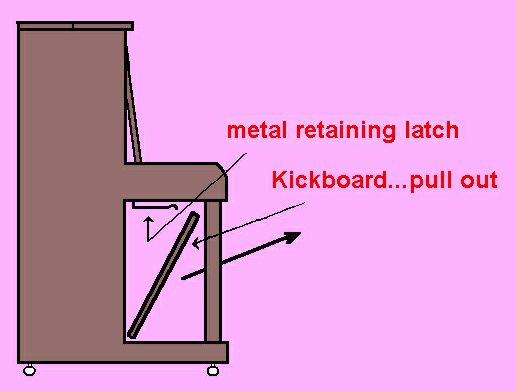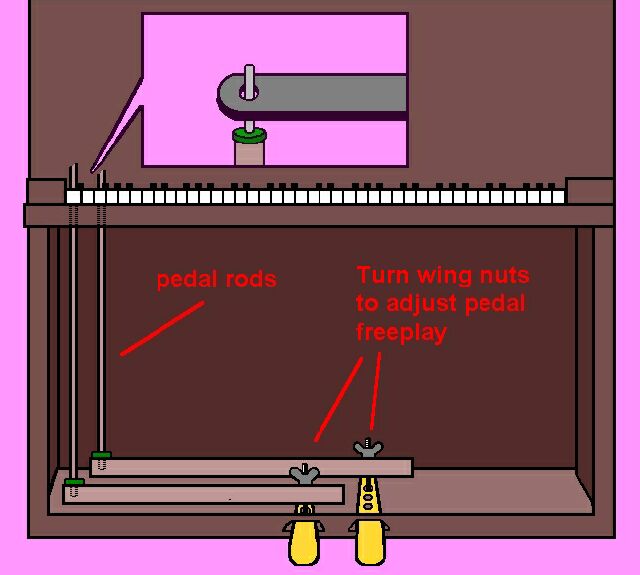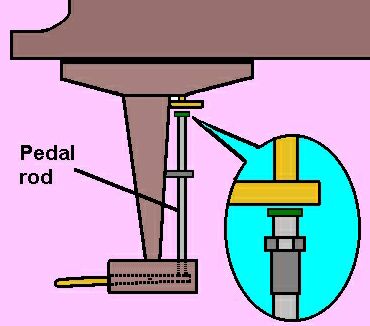

Adjusting the pedal rods on vertical pedals that aren't working is probably the most common adjustment the average piano tuner is called upon to make...and when you call a tuner to make that adjustment you'll no doubt pay a service charge, one that might be saved by taking a few minutes to look at what is really a rather simple mechanical device.
To view the pedal mechanism (called "trapwork" by tuners, for any of you who might care), you'll need to remove the "kickboard," the front cabinet piece of the piano, under the keyboard. This board is usually secured by a metal spring latch affixed to the underside of the keybed, right in the middle of the piano (or maybe two latchs, one on each side, in some older models). Depress the latch/latches and pull the board forward and out, as shown in the accompaning drawing.
As can be seen in the following generic illustration, the pedals are typically connected to horizontal wooden (or metal) see-saw type levers. Vertical wood dowel or metal rods connect to these horizontal levers and extend up into the piano to a mechanism in the action (a typical connection in the vertical action is shown in the inset). When you step on the pedal it causes the pedal end of the horizontal lever to move down, raising the opposite end, which in turn causes the vertical rod to rise, which then activates the appropriate action mechanism inside the piano.Click here to see grand pedal rods. The damper, or sustain pedal, is the truly important pedal on any piano and is always on the right. On verticals, the left pedal is usually a "soft" pedal, which simply moves the action closer to the strings to lessen the hammer's blow. Some vertical pianos have three pedals in imitation of grands. The middle pedal may have any one of several effects, from merely repeating the action of the damper pedal, or raising only the bass dampers as a unit, or dropping a practice "muffler" felt between the piano hammers and the strings to soften the tone. In any case, whatever their acoustic function, all vertical pedals are operated in the same fashion.
Some vertical pianos have three pedals in imitation of grands. The middle pedal may have any one of several effects, from merely repeating the action of the damper pedal, or raising only the bass dampers as a unit, or dropping a practice "muffler" felt between the piano hammers and the strings to soften the tone. In any case, whatever their acoustic function, all vertical pedals are operated in the same fashion.
Since the rods are usually only inserted into the action levers and the bottom horizontal levers with metal pins, it is very common for them to simply fall out of position, causing the pedal to no longer function and sending the piano player into a panic (there's nothing worse than trying to play a piano with no damper pedal). This is especially common after the piano has been moved, or if you are one of those players who stomp on the pedals to keep time (shame on you). Pedal rods usually fall out because there was too much "freeplay" in them.
Freeplay means that the pedal and the horizontal lever move too much before causing the vertical rod to rise. If the freeplay is severe enough it can cause the rod to fall out of position, as mentioned, or simply cause it not to rise enough to allow the appropriate action parts to work correctly (an example of this would be stepping on the damper pedal but not having the tone sustain). If this latter is the condition, you can adjust the wing nuts at the pedal until the play in the vertical rods is removed (see illustration). Newer pianos have convenient wing nuts, though older models may just have a conventional nut, requiring the use of pliers or a small wrench to turn. Proper adjustment calls for a freeplay of only about 1/16th of an inch...the pedal rod should begin to raise the mechanism as the pedal starts down a 1/16th of an inch when you step on it. In other words, if you grab the vertical rod you should be able to move it up and down only very slightly. If you adjust ALL the freeplay out, it may jam against the action parts and leave the pedal mechanism engaged when you don't want it to be (for example, causing the dampers to remain off the strings, letting the notes ring on).
If the vertical rod has fallen completely out, you will be obliged to lie on your back and stick your head inside the piano so you can see up into the action to insert the pin back into the appropriate action lever hole (a flashlight is a must here). Before you do this, however, check to make sure the rods still have the small round felt bushings on the ends (they are usually green, as shown in the inset of the illustration). If these bushings are missing the rod will make a clicking noise whenever the pedal is depressed. Sometimes the bushings are rubber and are inserted into the lever holes, rather than the rods, in which case they usually remain in place even if the rod has fallen out. Look closely at your particular piano to determine where the bushings should go. If you can't find any on the rods or levers, or lying around the bottom of the piano (mice love dining on this felt material), you can probably improvise new ones by cutting a piece of thick cloth and punching a hole in it for the pin to pass through, or simply wrapping the pin and the end of the rod with electrial or duct tape. When you replace the rod, be certain the pins are in the holes on both upper and lower levers, then tighten the wing nut to take up the freeplay. If all the rods have fallen out it may not be obvious which lever in the action operates which pedal, so you will simply have to experiment until you find the correct combination.
Grand piano pedals usually cause fewer problems than verticals, once again due to a better design. The grand pedal rods are encased in a wooden lyre  and usually cannot fall out of position. Nevertheless, they do need adjustments sometimes, and this is usually accomplished in the same fashion as in verticals. Though the grand pedal mechanism may look much different (the horizontal levers, for example, are above the vertical rods rather than below them), it works on the same principles (see the illustration). At the upper portion of the vertical rod there will be an adjusting nut of one sort or another (see inset) which you can turn up or down to control the pedal freeplay (Go back to vertical adjustment). On some very old grands, however, there may not be an adjusting nut. In these old models it is necessary to adjust the freeplay by placing felt or leather shims between the rods and the horizontal levers, an adjustment that is probably best left to your friendly piano tuner, who needs to make a living too, you know.
and usually cannot fall out of position. Nevertheless, they do need adjustments sometimes, and this is usually accomplished in the same fashion as in verticals. Though the grand pedal mechanism may look much different (the horizontal levers, for example, are above the vertical rods rather than below them), it works on the same principles (see the illustration). At the upper portion of the vertical rod there will be an adjusting nut of one sort or another (see inset) which you can turn up or down to control the pedal freeplay (Go back to vertical adjustment). On some very old grands, however, there may not be an adjusting nut. In these old models it is necessary to adjust the freeplay by placing felt or leather shims between the rods and the horizontal levers, an adjustment that is probably best left to your friendly piano tuner, who needs to make a living too, you know.